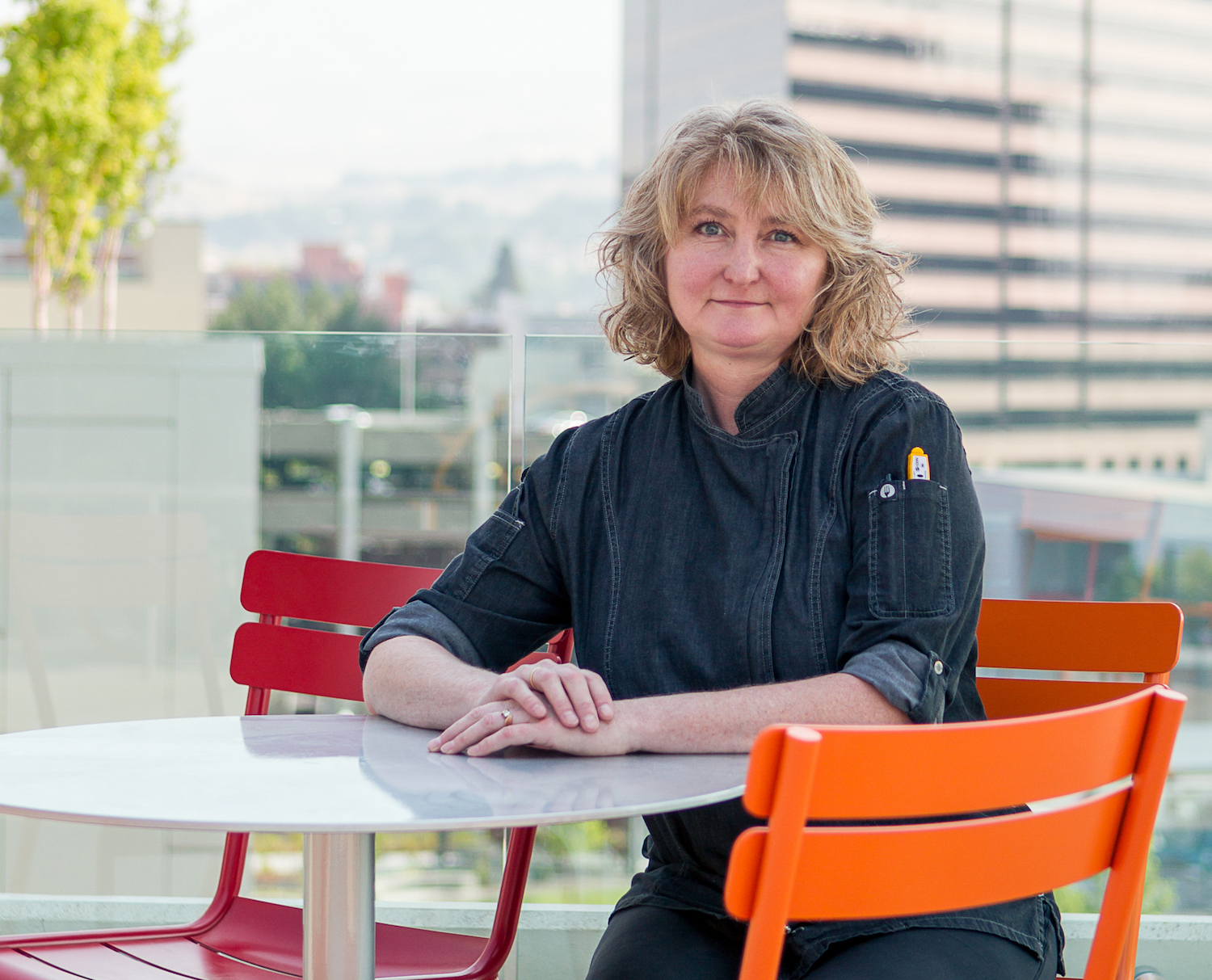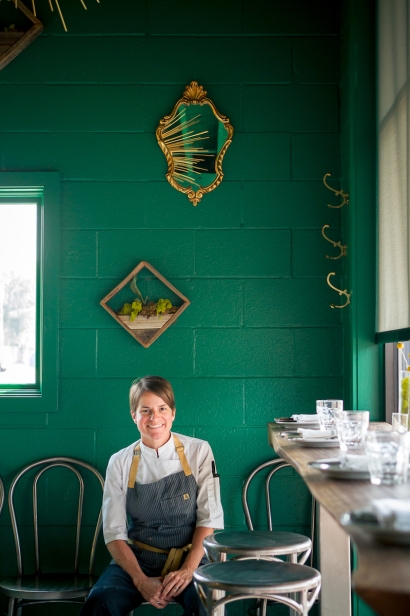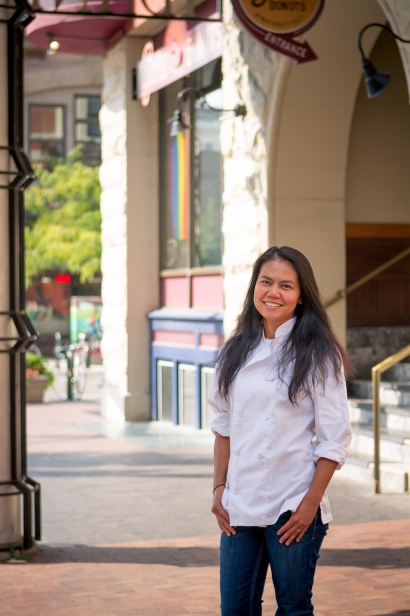They Beat The Heat: Idaho’s Women Chefs Break Kitchen Barriers but Remain a Rarity
Sit at Petit 4’s bar in front of the tiny French bistro’s open kitchen. There, you’ll get a direct view of gourmand artistry and culinary entertainment.
Patrons watch clams steam in complex herbal broths and legs of duck confit meld with hearty helpings of roasted tomato gratin cassoulets. Orders fly, haute burgers sizzle and the command of the chef make this live version of what could appear on the Food Network or the Travel Channel look like a well-orchestrated dance amid the dinnertime rush.
“I want to transport people to another place,” says Petit 4 Chef Sarah Kelly. “We want you to walk through the door and not feel like you’re next to the train tracks.”
But chefs like Boise’s Kelly remain a rarity and under represented in the culinary world. Female chefs comprise less than 22% of head chefs across the nation and far fewer gain celebrity status like the late Anthony Bourdain or earn those coveted michelin stars. Kelly says her work entails about 50% cooking. The rest of the time, there’s some heavy lifting.
“It’s not as glamorous as TV makes it out to be.”
Breaks remain rare and Kelly recalls a time when she went nine years with no holidays off.
“It sounds like a terrible job description,” she laughs.
And now there’s Yelp and social media, which puts every dish, dislike and dining disappointment on full public display.
“It attracts a certain type of individual. You have to take a lot of criticism,” Kelly says.
“You’ve got to be able to hold your own ground and not be too sensitive.”
History placed women squarely in the home kitchen but the rise of the celebrated chef in the late 16th century left women behind and put mostly men in the high-status and revered position of serving elite culinary whims. For centuries, the male chef ran the commercial restaurant while, as the saying goes, a woman’s place was in the kitchen—the home kitchen.
Women have proven that their place is in politics, business, higher education and on spaceships and in battlefields. And have crafted lives their grandmothers could only dream of, busted through thick glass ceilings and outpaced male counterparts in areas long considered the domain of men.
So why are so few women in the kitchens of the culinary elite, including in Idaho?
While women still log more hours than their male partners in the home kitchen and just about everyone has memories of mom’s best recipe, women today remain the familiar cook behind family dinners while the movers and shakers in the haute cuisine world remain male in a profession largely dominated by men.
In 2017, women comprised only 25% of Harvard Science and Cooking lecturers, and over the past five years typically represented from 7% to 30% of chefs at top culinary competitions and festivals.
Last year, more than 70% of James Beard Award chef finalists were men and in 2013, only 9% of Food & Wine Magazine’s Best New Chefs were women. And recently, zero women earned a spot on the World’s 50 Best list without sharing the honor with a husband, father or boss, according to eater.com. Zero.
So, if a woman’s place is in the kitchen, what gives?
“For many years, women were excluded from culinary schools, cooking competitions, and even working in certain venues. This helped create a workplace culture that was hyper-masculine, competitive, and generally unfriendly to outsiders, including women,” wrote Texas State University sociologist Deborah A. Harris, for a James Beard blog.
In Taking the Heat: Women Chefs and Gender Inequality in the Professional Kitchen Harris and co-author Patti Giuffre unraveled the core elements of the masculinized chef ’s kitchen to answer vexing questions about why so few women make it to the helms of elite professional kitchens and beyond. Interviews with 33 chefs and a dissection of culinary media exposed bias and structural barriers that accounted for gender discrepancies in the culinary professions.
“In the early years of their careers, they (women chefs) had to constantly prove that they were mentally and emotionally tough enough to fit in with all-male cooking environments. They had to prove themselves again when they moved up the culinary ladder and their leadership skills were tested by male chefs unused to taking orders from women. Some of our participants eventually left professional kitchen work behind. This had nothing to do with discrimination or mistreatment; instead, it was because female chefs found it impossible to balance the competing demands of having a family and heading a restaurant,” Harris wrote.
Chefs’ peak hours usually fall sometime between when school ends and bedtime begins. Lime and a Coconut Chef Sararak Sapiro simply told her husband she’d prefer to raise a restaurant than kids.
And executive chefs like Anna Tapia, who heads the culinary program for Boise’s Jack’s Urban Meeting Place, push to make work and family life balance out.
“My yard looks terrible and my dogs feel neglected,” Tapia says.
She recalls times when work in other restaurants was all-consuming and she put every bit of herself into her profession. At times she started at 5am and her youngest child would join her in the kitchen after school.
“We didn’t realize how much of a toll it would take on the family,” she says. “It’s not like on TV. It’s not glamorous. There’s heavy lifting. I go home and my back hurts, and my arms hurt.” Still, she says, “I love my job so much.”
There’s lifting, long hours, sweaty work environment, harsh criticism, foul mouths and, as the late Anthony Bourdain said, a culture of meathead masculinity.
While the #MeToo movement shamed several celebrity chefs out of their kitchens, the late Bourdain wrote extensively about the hypermasculine environment of professional kitchens—a culture he later disavowed as an outspoken proponent of the #MeToo movement.
“I provided validation for a meathead mentality, a bro culture that has not been good, particularly to women,” Bourdain said in a latenight television interview.
Kelly gives credits to the “solid guys” at Petit 4, but both she and Sapiro didn’t have female mentors along the way and they worked in largely male dominated kitchens. But the men in their culinary life, like Chef Sddy (a nickname for Noppadon Bunnag), who saw a budding chef in Sapiro during a stint at a Fairbanks, Alaska, restaurant, left a mark.
“I learned so much from him. He was, like, ‘You want to learn to cook? I could see you can cook,’” Sapiro recalls.
“Since I’ve been in restaurants I’ve been surrounded by men. There’s not a lot of women. But I can do whatever they can do. It’s a lot of work. It’s been intensive but I grew up on a farm and I’m used to hard work. I just did it. (eddy’s) the one that encouraged me.”
That hard work includes slinging pots that tip the scales at half her body weight. It’s not something you’ll usually see on the Food network.
But, “You can’t be it if you don’t see it,” touts The Representation Project, an advocacy initiative that aims to bring about political parity for women through accurate representations of women in the media.
Project founder Jennifer Siebel Newsom links women’s potential and the potential they see in themselves to the images they see of girls and women in the media. If we want to see women breaking barriers, we need to see more positive representations of women in the media, she says in her documentary film, Miss Representation.
Harris and Giuffre found the media hasn’t always encouraged women.
They found media perpetuated the culinary gender gap by constructing the profession as a masculine domain, which enabled elite chefs to see professional cooking in masculine terms and swayed the public to view men as better equipped to lead and manage kitchens. Their content analysis of culinary reviews and chef profiles found that men tend to earn accolades for innovation and testing the boundaries of establishment cuisine while women earn praise for more status quo, homestyle cooking.
“In the incredibly competitive restaurant industry where the hours are long, conditions are harsh, and profits razor thin, male chefs alone are often seen as culinary stars… (Yet), so many female chefs have proven themselves worthy and it is time to realize, when women lead, the entire culinary industry could benefit,” Harris wrote.
So, the next time you’re seated at an Idaho restaurant where the executive chef is a woman, consider yourself a witness to a rarity: a trail blazer who successfully beat the heat and rose to prominence in a professional kitchen.
Petit 4 | @eatatpetite4
Lime and a Coconut | @limeandacoconut
Jack’s Urban Meeting Place | @jumpboise
The Representation Project | @therepproject












